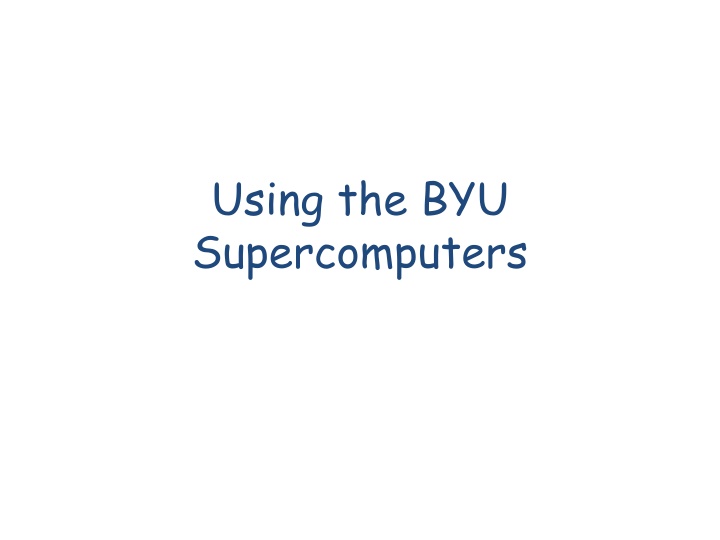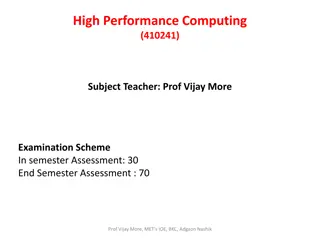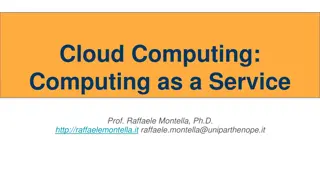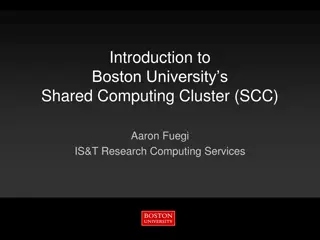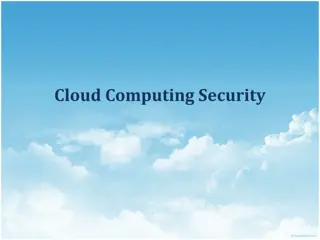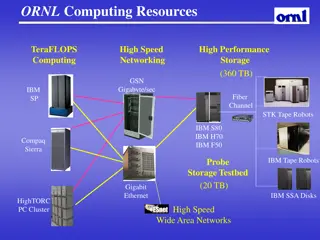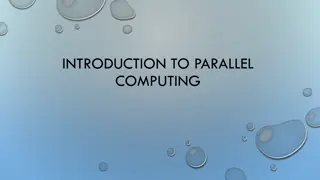Using BYU Supercomputers for High-Performance Computing
Harness the power of BYU supercomputers for advanced computing tasks. Learn about account activation, job submission, and job running processes. Explore scheduling jobs, job submission scripts, and job viewing commands. Take advantage of this cutting-edge technology for your computational needs.
Download Presentation

Please find below an Image/Link to download the presentation.
The content on the website is provided AS IS for your information and personal use only. It may not be sold, licensed, or shared on other websites without obtaining consent from the author.If you encounter any issues during the download, it is possible that the publisher has removed the file from their server.
You are allowed to download the files provided on this website for personal or commercial use, subject to the condition that they are used lawfully. All files are the property of their respective owners.
The content on the website is provided AS IS for your information and personal use only. It may not be sold, licensed, or shared on other websites without obtaining consent from the author.
E N D
Presentation Transcript
Using the BYU Supercomputers
Basic Usage After your account is activated: ssh yourid@ssh.fsl.byu.edu You will be logged in to an interactive node Jobs that run on the supercomputer are submitted to the batch queuing system You can develop code on the interactive nodes
Running Jobs The process User creates a shell script that will: tell the scheduler what is needed run the user s job User submits the shell script to the batch scheduler queue Machines register with the scheduler offering to run jobs Scheduler allocates jobs to machines and tracks the jobs The shell script is run on the first node of the group of nodes assigned to a job When finished, all stdout and stderr are collected back and given to the user in files
Scheduling Jobs Basic commands sbatch scheduling_shell_script sbatch scheduling_shell_script sbatch scheduling_shell_script squeue [-u username] scancel jobnumber sacct [-l]
Job Submission Scripts #!/bin/bash #SBATCH --time=01:00:00 # walltime #SBATCH --ntasks=64 # number of processor cores (i.e. tasks) #SBATCH --nodes=1 # number of nodes #SBATCH --mem-per-cpu=1024M # memory per CPU core #SBATCH -J "test" # job name #SBATCH --mail-user=myemail@gmail.com # email address #SBATCH --mail-type=END # Compatibility variables for PBS. Delete if not needed. export PBS_NODEFILE=`/fslapps/fslutils/generate_pbs_nodefile` export PBS_JOBID=$SLURM_JOB_ID export PBS_O_WORKDIR="$SLURM_SUBMIT_DIR" export PBS_QUEUE=batch # Set the max number of threads to use for programs using OpenMP. Should be <= ppn. Does nothing if the program doesn't use OpenMP. export OMP_NUM_THREADS=$SLURM_CPUS_ON_NODE https://marylou.byu.edu/ documentation/slurm/scri pt-generator mpirun hello
Viewing Your Jobs -bash-4.1$ sbatch hello.pbs ^[[ASubmitted batch job 7295257 -bash-4.1$ squeue -u mjc22 JOBID PARTITION NAME USER ST TIME NODES NODELIST(REASON) 7295257 m6n mpitest mjc22 CG 0:05 2 m6-18-[6-7] -bash-4.1$ sacct -j 7295257 JobID JobName Partition Account AllocCPUS State ExitCode ------------ ---------- ---------- ---------- ---------- ---------- -------- 7295257 mpitest m6n mjc22 30 COMPLETED 0:0 7295257.bat+ batch mjc22 30 COMPLETED 0:0 7295257.0 orted mjc22 2 COMPLETED 0:0
Developing Code Normal linux code development tools gcc, g++, gdb, etc. Intel compiler icc, ifort Editing vi emacs edit on your own machine and transfer Parallel code development icc openmp gcc fopenmp mpicc
-bash-3.2$ less slurm-7295257.out I am proc 7 of 30 running on m6-18-6 Sending messages Receiving messages I am proc 8 of 30 running on m6-18-6 Sending messages I am proc 9 of 30 running on m6-18-6 Sending messages I am proc 10 of 30 running on m6-18-6 Sending messages I am proc 0 of 30 running on m6-18-6 Sending messages Receiving messages 0: 1: Hello 0: 2: Hello 0: 3: Hello 0: 4: Hello 0: 5: Hello 0: 6: Hello 0: 7: Hello 0: 8: Hello 0: 9: Hello 0: 10: Hello I am proc 1 of 30 running on m6-18-6 Output stderr and stdout from each node are collected into files Jobname.oJOBNUM Jobname.eJOBNUM
Backfill Scheduling Job C 10 node system Job D Job B Job A time A B C D
Backfill Scheduling Requires real time limit to be set More accurate (shorter) estimate gives more chance to be running earlier Short jobs can move through system quicker Uses system better by avoiding waste of cycles during wait
